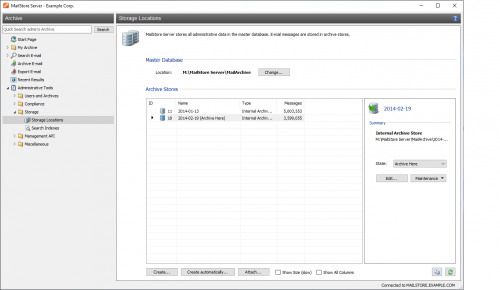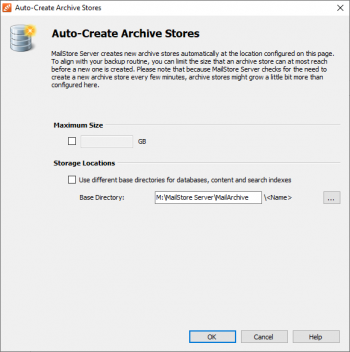Difference between revisions of "Storage Locations"
| [unchecked revision] | [unchecked revision] |
| Line 89: | Line 89: | ||
== Creating File Groups Automatically == | == Creating File Groups Automatically == | ||
| − | MailStore Server creates a new file group approximately every 500.000 messages and starts archiving new messages into the newly created file group. To change the default behavior, e.g. you want to create a new file group | + | MailStore Server creates a new file group approximately every 500.000 messages and starts archiving new messages into the newly created file group. To change the default behavior, e.g. you want to create a new file group quarterly, please proceed as follows: |
* Start MailStore Client and log on as MailStore administrator (admin). | * Start MailStore Client and log on as MailStore administrator (admin). | ||
Revision as of 18:03, 1 June 2011
Structure of the MailStore Database
A MailStore database consists of the following:
The Master Database
Every MailStore Server installation has exactly one master database where general information such as users, email folders and settings are stored. Compared with file groups (see below), the master database has a very small storage space requirement.
The master database is included in the setup of MailStore Server and is installed and set up automatically. Through the MailStore Server Configuration, the storage location of the master database can be determined and changed, if desired. The master database can be stored on a local drive or on a network location specified by an UNC path as well. For further information please refer to the article Using Network Attached Storage (NAS).
The master database is integrated in MailStore Server (embedded database) and can be run concurrently with other database systems.
File Groups
The actual data - the archived emails - is stored in file groups. During the initial installation of MailStore Server, a first file group is created automatically. To distribute the archive among several storage locations, any number of additional file groups can be added at any time. In addition to allowing for flexible management of the storage space, the creation of new file groups has a positive influence on the performance of the archive.
A file group consists of:
- Database - The database stores a list of the individual emails, including header information, as well as a list of indexes.
- Content - The actual email content is stored in .DAT files. Generally, these files have a manageable size of approximately 8 MB each, but individual files can vary considerably in size.
- Index - One index per user is created, which makes extremely fast searches possible within MailStore. In addition, indexes are used for navigation within the tree structure.
Managing Storage Locations
In Storage Locations Management, the location of the master database can be viewed and the file groups of the archive can be managed. The file groups contain the actual data, the archived emails; by creating new file groups the complete archive can be distributed among different storage locations (e.g. different hard drives); existing file groups can always be moved at a later time.
Accessing Storage Locations Management
Log on to MailStore Client as administrator. Click on Administrative Tools > Storage and then on Storage Locations.
Changing the Storage Location of the Master Database
Here, the storage location of the master database can only be viewed. By clicking on Change, only a summary of the steps (as described below) required to change the location is displayed:
Start the MailStore Server Base Configuration which is located in the MailStore Server program folder in the Windows Start menu (on the MailStore Server PC). Select the storage location of an existing master database (e.g. to restore a backup). If an empty directory is chosen, a new master database will be created.
Maintenance of the Master Database
The following features are available through Maintenance right of the Location field.
- Cleanup (FB Sweep)
Simple cleanup of the master database. - Rebuild (FB Backup+Restore)
Complete rebuilding of the master database (e.g. if structural problems occur).
Creating a New File Group
To create a new file group, click on Create... in the menu bar at the bottom of the window. Select an empty directory and click on OK or just enter a name to create a new file group in the same directory as the master database.
Store Newly Archived Email In...
Select the file group into which new emails are to be archived. Right-click on the file group and select Archive Here. Only file groups that are not write-protected can be chosen; their status can be changed at runtime.
Write-Protecting a File Group
Select a file group from the list, right-click on it an select Write Protect.
The emails stored in a write-protected file group remain fully available to MailStore users and can be located through the folder structure or by running a search. However, neither can new emails be archived into this file group nor can existing ones be deleted from it. Please keep in mind that the file system still requires write access to the file group.
After a file group has been write-protected, it is marked in the list with a lock symbol next to it.
To remove the write-protection, select the appropriate file group and click on Write Protect again.
Attaching and Detaching File Groups
Existing file groups can be detached from the archive: Simply select a file group from the list and right-click on it and select Detach from the menu. Once detached, the file group and the emails contained therein are no longer available in the archive. This feature can be used for taking old parts of the archive out of storage, for example.
A detached file group can be reattached to the archive at any time: by clicking Attach..., the file group becomes fully available again. Please note: Only file groups which originated from the same archive can be attached; file groups from external archives cannot be integrated.
Moving File Groups
To move a file group, please proceed as follows:
- Detach the file group to be moved: Select the appropriate group from the list and click on Detach.
- Use Windows Explorer to move the file group to a different directory on any local(!) network.
- Reattach the file group: Click on Attach and select the new storage location of the file group. Click on OK to confirm.
Maintenance of the File Groups
All available maintenance commands are available by right-clicking onto a file group from the list. Alternatively by selecting a file group and clicking on Selection in the menu bar on the bottom of the window. Following functions are available:
- Free Unused Disk Space
- Check Data Integrity
- Cleanup (FB Sweep)
Simple cleanup of a file group database. - Rebuild (FB Backup+Restore)
Complete rebuilding of a file group database (e.g. if structural problems occur). - Recalculate Statistics of all File Groups
Creating File Groups Automatically
MailStore Server creates a new file group approximately every 500.000 messages and starts archiving new messages into the newly created file group. To change the default behavior, e.g. you want to create a new file group quarterly, please proceed as follows:
- Start MailStore Client and log on as MailStore administrator (admin).
- Click on Administrative Tools > Storage and then on Storage Locations.
- Click on Create automatically....
- Adjust the settings in the Auto-Create File Groups window to your needs.
Important notice: Refer to Choosing the Right Storage Strategy for additional important information. - Under Create in enter a path where to create the automatically created file groups directories. MailStore always adds year-month to the name of the file group directory.
- Click on OK to confirm the settings.


